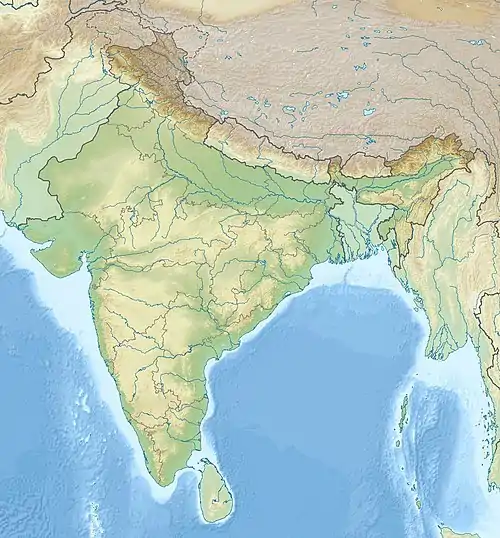Khajuraho | |
|---|---|
town | |
 Khajuraho  Khajuraho | |
| Coordinates: 24°51′N 79°56′E / 24.85°N 79.93°E | |
| Country | India |
| State | Madhya Pradesh |
| District | Chhatarpur |
| Elevation | 283 m (928 ft) |
| Population (2011) | |
| • Total | 1,762,857 |
| Languages | |
| • Official | Hindi |
| Time zone | UTC+5:30 (IST) |
The Khajurāho Hanumān inscription is an epigraphic record on the base of a colossal figure of Hanuman, located at the temple site of Khajuraho in Madhya Pradesh, India. The inscription dates to the tenth century CE. The Hanumān is under the protection of the Archaeological Survey of India, being listed as a monument of national importance.[1]
Location
The inscription is on the base of a well-known image of Hanumān at Khajurāho. Because the figure is under worship and the shrine renovated, the inscription is not presently visible.
Publication
The inscription and the image of Hanumān are frequently mentioned in the literature on Khajurāho.[2] The inscription was first noticed by Alexander Cunningham in the nineteenth century.[3] D. R. Bhandarkar revisited the inscription in 1904 and published a new reading, in addition to a fresh interpretation of the date.[4]
Description and Contents
The inscription is written in Sanskrit in three lines. The style of the characters supports a date in the tenth century CE.

Historical Significance
The Khajurāho inscription is of great importance for the history of Hinduism because it gives a date of 316. This is taken by historians to refer to the Harṣa era, thus giving a date of 922 in the common era. While there are certainly figures of Hanumān that are older than the tenth century, this inscription makes the Khajurāho image the oldest dated Hanumān currently known.
Text
The uncorrected text reads as follows:
Left side:
- oṃ gollāgāhīlapūtrasya
- saṃvatsro °300 10 6° māghaśudi 10°
- śrīhanumantaṃ g[o]llākaḥ praṇamati
Right side:
- gahilasya sutaḥ śrīmānhanumānpa
- vanātmajam aṇukṛod dharmmam ā-
- lokya gollākāprākataṃ harim
Translation
part I
- oṃ. [The record of] Gollā, son of Gāhīla.
- The year 316 on the 10th day of the bright fortnight in the month of Māgha.
- Gollāka bows to Śrī Hanumān.
part II
- Gollāka, the son of Gahila, having beheld the umanifest Hari,
- afterward made this religious work, the glorious Hanumān, the son of the wind.
See also
References
- ↑ See http://www.asibhopal.nic.in/monument/all_monument2.html
- ↑ Devangana Desai, The Religious Imagery of Khajuraho (Mumbai, 1996): 21 and figure 19.
- ↑ Cunningham, ‘XXII. Khajuraho’, ASIR 2 (1862-65): 437 where he tenatively suggests a date of 925.
- ↑ Government of Bombay, General Department. Progress Report of the Archaeological Survey of Western India, for the year ending 30th June, 1904.
External links
- Image by the Archaeological Survey of India